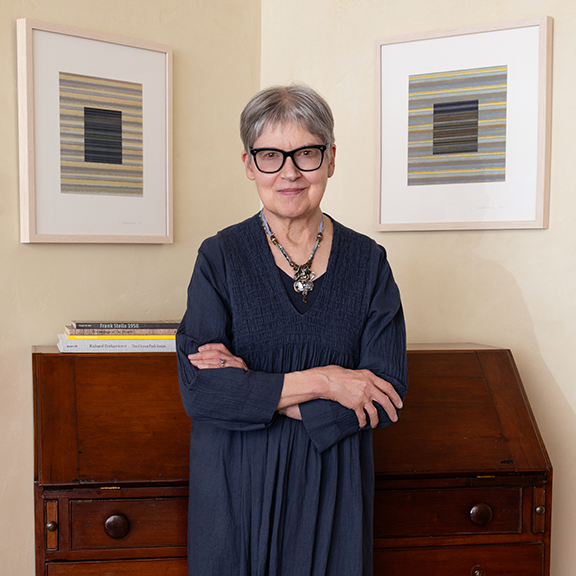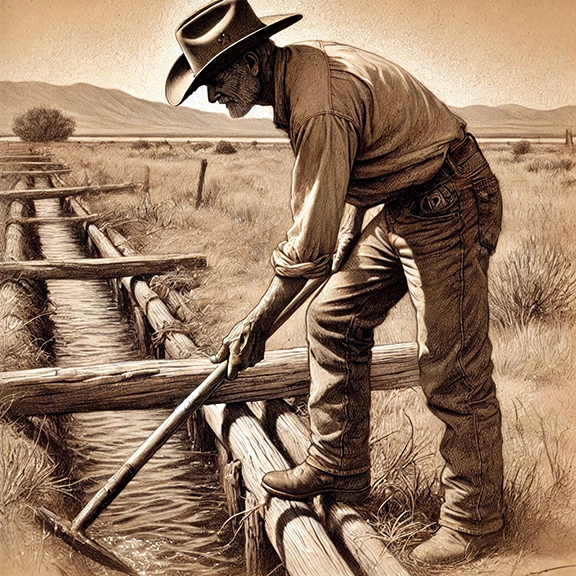The Keeping of the Springs
By Paige Boucher
This article originally appeared in Inside | Out in the Winter 2023 issue of Art with Altitude.
A soak in the Old Town Hot Springs (OTHS) pools is always rejuvenating, but the experience can also be a journey through time and place when you consider where the water comes from and where it is going. Bathing or swimming in a natural hot spring beats soaking in a hot tub or spa. The water is filled with natural minerals and is constantly refreshed, bubbling up out of the earth through layers of rock and sediment, swirling through the pools, and then going on its path along a network of rivers to the Pacific Ocean.
Thermal hot springs are a precious natural phenomenon, but as we have learned over the past century, they are fragile. “Keeping” the springs and the water that rises from them takes forethought and dedication from our community.
The hot spring that feeds the OTHS hot pools and community pool is one of 10 managed springs. When Steamboat Springs was first settled by white people, there were said to be more than 150 springs within a two-mile radius of downtown. Over the years, many of those springs have been lost to development, impact from cattle drives and beautification projects. Several of the remaining springs are named and on city property, some appear only in especially wet years, and others, including the OTHS Heart Spring, are privately protected.
“Groundwater travels along fractures to depths of about 12,000 feet below the surface and is then heated by the normal geothermal gradient, which then rises along a series of faults in the valley,” said Audrey Walker, geology professor at Colorado Mountain College. “At about 102 degrees Fahrenheit, the water at Heart Spring is not chlorinated but does contain comparatively very few natural minerals including bicarbonate—which makes the little bubbles in the spring—calcium, carbonate, a little potassium, sodium and sulfate, though this is the least odoriferous of our local springs.”
The springs in the area have long been a treasured resource and gathering place. Before Europeans arrived, the Ute people summered in the valley and considered the springs to be a source of physical and spiritual healing. In 1872, Missourian Colonel James Crawford arrived in the valley. The abundant beauty and potential of the springs to create future commerce convinced him it was the ideal place to settle his family. He claimed a homestead near Steamboat Spring, becoming the first permanent settler and, in 1874, he became the founder of the township of Steamboat Springs. Crawford built a log shelter over the top of what today is known as the Old Town Hot Springs to create a bathhouse for the growing community of homesteaders and miners, naming it Bath House Spring.
When the railroad arrived in 1909, a stone structure replaced the log cabin and indoor and outdoor pools were built. Steamboat Springs began to attract its first tourists, who came to bathe in the numerous mineral springs, all said to have their own specific healing properties. They also drank from Soda Spring, a naturally carbonated spring, adding a lemon wedge or lemon syrup to create fizzy lemonade.
But with progress can come destruction. The arrival of the railroad caused the first known damage to one of our beloved springs—Steamboat Spring. The spring is located across the Yampa River from what today is the Bud Werner Memorial Library, but at the time was the famous 100-room Cabin Hotel. The geyser, believed to be the only one in Colorado, expelled jets of water up to 14 feet in the air and sounded like a chugging Steamboat, which is where the town derived its name. However, blasting for the railroad damaged the foundation of the spring, and the geyser and chugging ceased. As recently as 1988, Steamboat lost the famous Soda Spring when the highway was expanded and workers attempted to pipe the spring underground. The spring chose another path and has not been seen since.
In 1931, a businessman from Indiana, Henry W. Gossard, leased Bath House Spring and Lithia Spring from the town of Steamboat Springs. He built a heart-shaped stone wall around the spring and renamed it Heart Spring for marketing purposes. He called his new business the Rocky Mountain Miraquelle Spa. As part of his belief in the healing powers of the spring, he planned to bottle and sell Lithia Spring mineral water as a health product. However, the Great Depression put a damper on those plans. The springs and land were returned to the town in 1935.
Despite the aging infrastructure, Heart Spring continued to be an important asset and gathering place for the community as many local residences did not have hot water at the time. To afford the maintenance of the spring and pools, a nonprofit corporation, Steamboat Springs Health and Recreation Association (SSHRA), was formed in 1935. When the spring and pools were condemned in 1968, the nonprofit produced a plan to sell lifetime memberships to finance the rebuilding of the pools.
Pat Carney arrived in Steamboat Springs in the early ‘70s to ski at the newly established ski area for, what she thought, would be a few seasons after graduating college. However, she was recruited to be the SSHRA pool manager in 1975, and she never left. From the beginning Pat was determined to keep the nonprofit afloat and had a vision for improving it.
Responding to the growing popularity of the hot springs among locals and tourists, and under Pat’s diligent care, the nonprofit grew over the years with the addition of a slide and fitness center. Pat also was dedicated to preserving the quality of the water that drained into the Yampa River and eventually into the Colorado River, the main water source for many Western states.
At the beginning of her long career at OTHS, Pat had a staff of five that did everything from lifeguarding and cleaning to managing the desk and the budget. Team members learned as they went, and sometimes the lessons were difficult. Annually, to clean the pool, they would drain it into the Yampa River. In her first year on the job, she realized this practice caused the unintended negative consequence of overheating the river. The team quickly realized it needed to better control the flow of water into the river.
Pat and the community understood they needed to take better care of their natural resources. The 2000s brought more growth and tourism to the valley, which meant new challenges for those dedicated to “keeping” the springs. The nonprofit adopted the business trade name “Old Town Hot Springs” and added more hot pools. Pat retired in 2017, turning over leadership of OTHS to Stephanie Orozco.
Led by Orozco, today the 40-plus employees at OTHS are the “keepers” who take care of all aspects of the OTHS and include the management team, facilities team, lifeguards, swim instructors, fitness teachers and more. Employees often seek work at the nonprofit because of fond memories of visiting the springs as a child or because they want to take part in protecting the spring and the water at the headwaters of the Colorado River. They test the water daily with more extensive tests weekly to ensure added chlorine is completely removed along with sunscreen and other foreign substances, before it crosses under Highway 40 and flows into the Yampa River at what is known as the Hippie Hot Springs.
As protectors of Heart Spring and the oldest nonprofit in the Yampa Valley, the team balances every request for a free pass with the funds needed to pay the bills. They are always aware of the paramount need to ensure that every child in the valley learns to swim, and of the weight it takes to maintain the infrastructure that allows the hot spring to form pools for the enjoyment of so many people.
By the mid-2010s it became apparent that the OTHS lap pool, which continues to be the valley’s only public swimming pool, was aging out of its useful life and needed to be replaced. Upgrades had not happened since the 1980s and the footprint hadn’t changed since the 1960s. A new pump house, an additional hot pool to accommodate growing demand, a community pool, and a regulation-distance lap pool for the swim team, swimming lessons, aquatic physical therapy, and recreational fun all are encompassed in construction taking place through summer 2024.
Looking back at the knowledge gained since the Crawford family first settled in the valley, the OTHS staff and community knows that “keeping” the springs and mineral waters includes planning for future generations. The OTHS team is working with experts in the field to make sure they are following all regulations and requirements to protect the spring as the renovations proceed.
New protections are also being put into place for the city-owned mineral springs. A new Mineral Springs Committee was formed in 2022 under city leadership. The committee’s job is to create protections for the springs and provide recommendations for new standards and regulations regarding maintenance and development near the springs.
Today, new springs are bubbling up downtown, reclaiming their environment, proving that springs ebb, flow, disappear and reappear. Secrets the springs hold in regard to their healing properties, how they impact the surrounding environment and the beings that live in and around them, are still being revealed.
The springs, including Heart Spring, will continue to bubble and flow from the earth, making their way into the Yampa River and beyond. There is no stopping nature because flowing water always wins. Steamboat’s Heart Spring allows for a moment of reinvigorating enjoyment, a pause in an otherwise hectic world. Since the first springs were discovered they have been used for healing and nourishing people, animals and the environment.
“Old Town Hot Springs is more than a recreation center; it’s a source of vitality for our community. It’s the heartbeat, where generations have come together to share in its warm embrace, creating memories that endure as long as its healing waters,” said Orozco. “This place is special, and we intend to keep it that way for generations to come.”
Elevate the Arts: To raise funds needed to ensure that there will be a public swimming pool for generations to come, the OTHS has launched the “It’s in the Water” capital campaign to raise the $10 million required for its current project. Although the community has wrapped its arms around the project, $5 million still is needed. To become a “Keeper” of the hot springs, donate at oldtownhotsprings.org/capital-campaign/.




